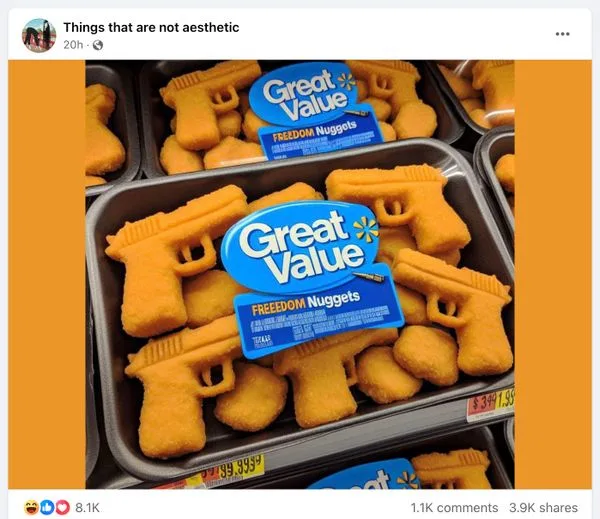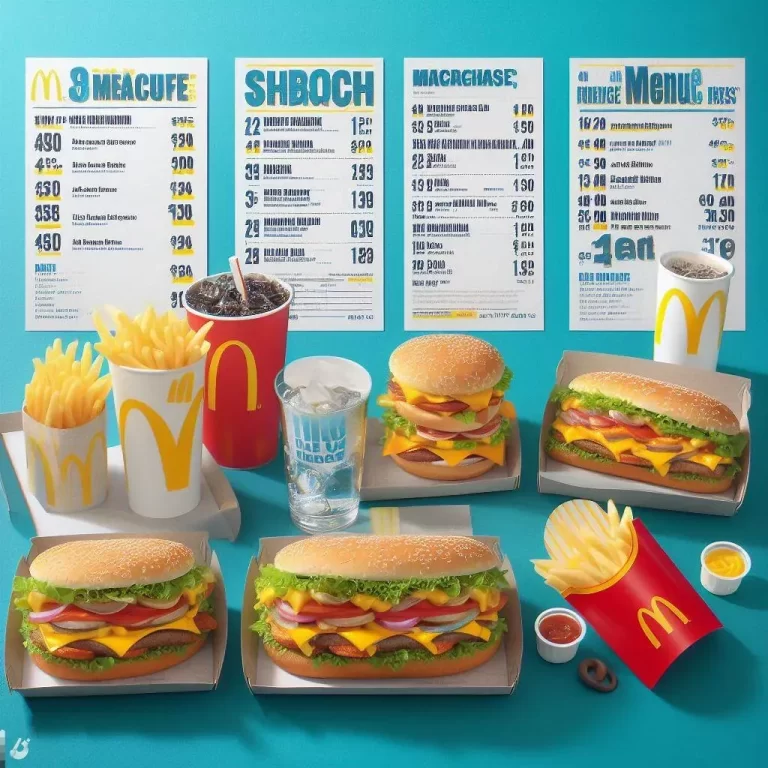Does Walmart sell Freedom Nuggets? Know The Fact!
Recently, social media has been buzzing with “Freedom Nuggets,” which purportedly features chicken nuggets shaped like pistols sold by Walmart. The image of these so-called nuggets has gone viral, garnering tens of thousands of shares on platforms like Facebook. However, this buzz has raised questions about the authenticity of such a product.
Our investigation reveals that the image circulating online is a clever fabrication created using artificial intelligence. Walmart has confirmed that it does not offer chicken nuggets designed to resemble firearms. We will delve into the details surrounding the “Freedom Nuggets” phenomenon, exploring how misinformation can spread quickly and the importance of verifying claims before sharing them.
Table of Contents
The Viral Facebook Post

The viral Facebook post about “Freedom Nuggets” caught many users off guard. It quickly spread, fueled by curiosity and surprise. The image showed chicken nuggets shaped like tiny pistols, branded as “Great Value Freedom Nuggets.” It was initially shared on a Facebook page named “Things that are not aesthetic” and then reposted thousands of times.
The post even included a screenshot that appeared to be from Walmart’s website, adding to its credibility. But as it turns out, the screenshot was fabricated. This viral post tricked many into believing Walmart would sell such a controversial product. The sheer number of shares and comments demonstrates how easily misinformation can spread on social media. The allure of something so bizarre was simply irresistible to many.
Examining the Image’s Authenticity
The image of the “Freedom Nuggets” has several glaring flaws. Firstly, the word “freedom” contains an extra ‘e,’ which is a common mistake in AI-generated content. Additionally, the numbers in the prices below the packages appear distorted and unnatural. These oddities often serve as telltale signs of an artificial image.
Another clue is the inconsistent text fonts and spacing, which further cast doubt on the image’s legitimacy. The packaging in the image also lacks the typical branding details you’d expect from a Walmart product. Lastly, our fact check confirmed that Walmart’s official website lists no such product. These elements strongly indicate that the image was digitally manipulated rather than an authentic photograph of a genuine Walmart item.
Walmart’s Product Listings
| Aspect | Details |
| Product Listings | Walmart offers a wide range of items, including groceries and electronics. |
| “Freedom Nuggets” | No evidence of “Freedom Nuggets” or firearm-shaped chicken nuggets on Walmart.com. |
| Product Shape Claims | Walmart carries various chicken nugget shapes (e.g., traditional, dinosaur), but not firearm-shaped. |
| Brand Values | Walmart focuses on family-friendly products that align with its brand values. |
| Verification | Listings on Walmart’s website are accurate and verified. |
| Fact-Checking | The absence of “Freedom Nuggets” underscores the importance of verifying online claims. |
The Role of Artificial Intelligence

Artificial intelligence (AI) has significantly advanced, enabling the creation of highly realistic images. AI tools can generate convincing photos that often trick viewers. In the case of “Freedom Nuggets,” AI played a pivotal role. Using sophisticated algorithms, these tools can mimic natural product photography. However, subtle errors like misspellings and distorted text often reveal their artificial origin.
Transitioning from text to image generation, AI seamlessly combines elements, creating seemingly authentic content. The viral “Freedom Nuggets” image is a prime example of AI’s capabilities and pitfalls. Social media users, intrigued by the bizarre concept, shared it widely. Thus, while AI offers powerful creative tools, it also necessitates vigilance. Understanding AI’s role in creating such images can help identify and debunk hoaxes.
The Creator of the Image
The creator behind the viral “Freedom Nuggets” image is Chris Torres. He posted it in the Cursed AI Facebook group on May 16. Torres is known for generating content using artificial intelligence. His work often features bizarre and humorous themes, making them ripe for viral attention. The “Freedom Nuggets” image was one of his standout creations.
Torres’ playful approach with AI tools led to the widespread belief that Walmart was selling pistol-shaped chicken nuggets. Additionally, he posted another image showing “Great Value Liberty Nuggets” shaped like bullets. This further showcased his talent for creating attention-grabbing, AI-generated content. As a member of the Cursed AI group, Torres consistently engages with an audience that appreciates these quirky, computer-generated images.
Public Reaction to the Viral Image
Public reaction to the viral “Freedom Nuggets” image was swift and varied. Many users were shocked and amused by the idea. Comments ranged from outrage to hilarity, with some expressing disbelief. Transitioning quickly, the post garnered tens of thousands of shares. Some users praised the creativity behind the concept.
Others were appalled, thinking it inappropriate for a family-friendly store. Debates erupted, with people questioning Walmart’s judgment. Amid the frenzy, some skeptics urged others to fact-check. Memes and parody posts soon followed, amplifying the image’s reach. Influencers and bloggers joined the conversation, adding their takes. The image tapped into cultural divides, making it a hot topic. Ultimately, the reaction underscored how powerful and polarizing viral content can be.
The Importance of Fact-Checking

Fact-checking is crucial in today’s fast-paced digital world. Misinformation spreads quickly, causing confusion and potential harm. Transitioning from skepticism to verification helps prevent the spread of false claims. When you come across a startling image or claim, take a moment to investigate. Look for reputable sources that confirm or debunk the information. Fact-checking sites and official pages, like Walmart.com, provide reliable data.
Check for inconsistencies in the content, such as misspellings or odd graphics. Transitioning your mindset to prioritize verification protects you and others. Avoid sharing content based solely on initial impressions. By fostering a habit of fact-checking, you contribute to a more informed and trustworthy online community. This practice ultimately combats the spread of misleading information and promotes accuracy.
How to Identify Fake Images?
| Identifying Features | Description |
| Text Errors | Look for misspellings or odd characters in text; AI-generated images often have minor errors. |
| Distorted Numbers | Examine the numbers; unnatural or distorted numerals can be red flags. |
| Font and Spacing Consistency | Check for uniform text styles; authentic images typically have consistent fonts and spacing. |
| Color and Lighting | Transitioning to colors, look for unusual hues or lighting, which can indicate image manipulation. |
| Composition Inspection | Inspect the overall composition; elements that appear out of place or poorly blended may signal a fake. |
| Source Verification | Verify the image’s source; trusted websites and official pages provide credibility. |
| Reverse Image Search | Use reverse image search tools to trace an image’s origin and find where else it appears online. |
| Context Consideration | Always consider the context; if the claim seems too bizarre, it likely is. |
| Trust Your Instincts | Stay vigilant and trust your instincts when evaluating the authenticity of an image. |
Social Media’s Role in Spreading Misinformation

Social media platforms can amplify misinformation at a startling rate. Users often need to verify its accuracy to share content. The allure of sensational or bizarre stories is hard to resist. This impulsive sharing fuels rapid dissemination. Viral posts capitalize on this behavior, like the “Freedom Nuggets” image. Algorithms prioritize engaging content, pushing it to wider audiences. As a result, even misleading information gains massive reach.
Influencers and celebrities may unknowingly spread false claims further. Transitioning swiftly, their vast follower base amplifies the misinformation. The echo chamber effect then magnifies these unverified stories. Users encounter similar posts repeatedly, reinforcing false beliefs. To combat this, platforms are implementing fact-checking measures. However, the sheer volume of content makes complete oversight challenging. Public awareness and responsible sharing are essential to curbing misinformation.
Frequently Asked Questions
Are “Freedom Nuggets” real?
No, “Freedom Nuggets” are not genuine. The image circulating online was created using artificial intelligence and is not an actual product sold by Walmart.
How did the “Freedom Nuggets” image go viral?
The “Freedom Nuggets” image went viral after being shared on a Facebook page called “Things that are not aesthetic.” Its bizarre concept was reposted thousands of times, captivating social media users.
What are some signs of AI-generated images?
AI-generated images often contain misspellings, distorted numbers, and inconsistent fonts. These anomalies can be subtle but are usually clear indicators of digital manipulation.
Who created the “Freedom Nuggets” image?
The “Freedom Nuggets” image was created by Chris Torres and posted in the Cursed AI Facebook group. He is known for generating humorous and bizarre content using artificial intelligence tools.
Conclusion
The “Freedom Nuggets” hoax highlights the power and pitfalls of AI-generated content. It captivated social media, spreading misinformation rapidly. This serves as a reminder of the need for vigilance. Always fact-check sensational claims before sharing. Social media’s role in spreading such content cannot be understated.
We must develop a critical eye to discern truth from fabrication. Walmart confirmed no such product exists, reinforcing the importance of checking official sources. Misinformation can easily sway public opinion, leading to unnecessary debates. As AI technology advances, so does the sophistication of these hoaxes. We can better navigate the digital landscape by understanding AI’s capabilities and limitations. Staying informed and skeptical is critical to combating false information. Let’s prioritize accuracy and contribute to a more truthful online community.





